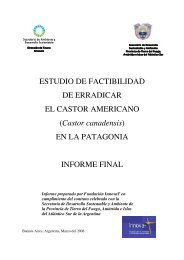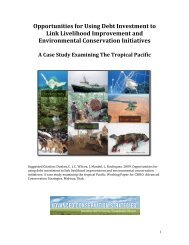Isabela eps:Layout 1 - Advanced Conservation Strategies
Isabela eps:Layout 1 - Advanced Conservation Strategies
Isabela eps:Layout 1 - Advanced Conservation Strategies
Create successful ePaper yourself
Turn your PDF publications into a flip-book with our unique Google optimized e-Paper software.
THE PROJECT ISABELA<br />
6<br />
Foreword from Project Leaders<br />
“The necessity to conserve Galapagos, Natural World Heritage” “The PI restoration plan called for helicopters to be used as shooting<br />
platforms, species-specific trained dogs, high quality hunters<br />
and Judas goats, and was budgeted at $8.5 million”<br />
Felipe Cruz, Charles Darwin Foundation, Co-Director of Project <strong>Isabela</strong><br />
The development and successful expansion of our species has produced the secondary effect of causing the extinction of<br />
hundreds of species, an extinction which has been unnaturally rapid. All modern vertebrate extinctions have probably<br />
been caused by man. On oceanic islands the situation is particularly delicate. These sites represent only 7% of the earth’s<br />
surface, and less than 10% of bird species are present on islands, but more than 80% of the birds which have gone extinct<br />
were island forms. Of the 396 species of birds cited by IUCN as threatened, 236 (60%) are island endemics.<br />
There are three principle causes which explain this catastrophic phenomenon 1) hunting and/or over exploitation (as in<br />
the case of the land tortoises); 2) the impact of introduced species and 3) habitat destruction.<br />
The rate of extinctions ke<strong>eps</strong> speeding up. In conservation biology one no longer talks about avoiding the extinction of<br />
species, but now it is a discussion as to which species can be saved. We are rather like a collective Noah, deciding with<br />
a biblical coldness which life forms will be able to accompany us on our new journey in the Ark. The world state<br />
continues to get worse, but in Galapagos we still have the opportunity to reverse this trend because the human presence<br />
is fairly recent; because the impacts of the invasive species are reversible; because here we still maintain 95% of the<br />
native and endemic biodiversity; and, because of geographical isolation, we can help to protect the area with strict<br />
processes which make the arrival of new invasive species more difficult.<br />
Throughout the world many plant and animal species are at a level of threat which has not been registered at any<br />
previous moment in history. It is therefore not at all surprising that protection of the biodiversity is one of the biggest<br />
priorities for conservation on a world level. In this context Project <strong>Isabela</strong> is an example of restoration of ecosystems on<br />
a scale never carried out before. Until now, the conservation world thought it impossible to work on this scale. We have<br />
achieved, in record time, the reversal of the degradation processes that were occurring on <strong>Isabela</strong> and Santiago,<br />
improving by 60% the conservation status of the native and endemic species of Galapagos. Through the combining of<br />
effort and knowledge and with the strengthening of local capacities, we consider that this is pioneer work and we are<br />
sure that the possibilities of replicating it will be of help on a world scale.<br />
We can not afford to lose even one species of our world heritage without in some manner impoverishing our society and<br />
that of future generations. Probably the experts in conservation do agree that Project <strong>Isabela</strong> achieved the recovery of the<br />
habitat and the protection of the species in these areas, on a scale never attempted before, through an initiative which<br />
combined previous experiences and developed new forms of confronting problems. Even though the initial costs may<br />
have seemed high, the final benefits are greater than the investment.<br />
Our world heritage is not an acquired right, but an undeniable inheritance for future generations.<br />
Victor Carrion, Galapagos National Park, Co-Director of Project <strong>Isabela</strong>, (Responsible for the Area of<br />
Control and Eradication of Introduced Species in GNP).<br />
The Galapagos Islands are located approximately 1,000 kms from the continent, and were formed by volcanic eruptions.<br />
They have a land surface of 7,970 km 2 and a Marine Reserve of approximately 138,000 km 2 , and maintain an important<br />
level of biological diversity and endemism. Of all the species identified in Galapagos (more than 5,000) about 1,900 are<br />
endemic and 74 are threatened. The animal species most representative of the islands are the Darwin finches, the Galapagos<br />
penguin, the flightless cormorant, giant tortoises, marine and terrestrial iguanas and amongst the plants, the Scalesia and<br />
Miconia. 95% of the original biodiversity has still been maintained. The extinctions of mammals (various species of endemic<br />
rice rats) which have occurred have been due principally to the effects of species (such as the black rat) introduced by man.<br />
Of the land surface, more than 96% is protected by the State, and this was declared a National Park in 1959. In 1978 the<br />
Park was included in the list of World Heritage Sites of UNESCO (United Nations Educational, Scientific and Cultural<br />
Organization); in 1984 it became part of the network of the World Biosphere Reserves in the UNESCO program, Man and<br />
the Biosphere and in 1998 UNESCO declared the Marine Reserve of Galapagos as a protected area and World Heritage Site.<br />
This Reserve covers all the interior waters as well as extending to 40 miles around the islands measured from the most extreme<br />
points (base line).<br />
The arrival of man in Galapagos provoked the beginning of the progressive deterioration of the natural environment of the<br />
islands, particularly because of the deliberate introduction of species of plants and animals for subsistence farming in these<br />
“inhospitable” islands. The surroundings which these species found on their arrival was such that they could colonize in an<br />
accelerated manner, escaping man’s control and becoming from then on, one of the worst threats to the island ecosystems.<br />
The efforts which are now necessary to reverse these impacts keep increasing. In some cases the future is very bright but in<br />
others it is very uncertain as we still do not have mechanisms and techniques to cause the drastic reductions necessary in the<br />
populations of invasive species such as rats, cats, anis, and the plants such as blackberry, guava, cinchona and a host of<br />
invertebrate species.<br />
This Document; Karl Campbell, Christian Lavoie & PI Team<br />
The Project<br />
The Project <strong>Isabela</strong> Atlas is an illustrative document that provides a step-by-step overview of Project <strong>Isabela</strong>’s activities and<br />
achievements. The primary role of this Atlas is to provide a visual and easy-to-read outline of the strategy, methods, results<br />
and magnitude of the eradication challenges.<br />
Managing a large intensive project with different methods being employed sequentially and others simultaneously was<br />
facilitated by a geographical information system (GIS), a system that was designed and implemented for managing most of<br />
the spatial data. This, along with a database for managing effort and kill data allowed information to be accessed in a timely<br />
manner by managers in the field, while also forming the basis for further analyses and publications. The Atlas shows many of<br />
the visual tools used by managers and hunters on a daily basis to facilitate their activities. These tools increased the efficacy<br />
of the project and dramatically improved our ability to achieve concrete results.<br />
The Atlas’s intended audience is broad, from the general public to conservation practitioners and eradication specialists.<br />
Many of the examples included here on how we conducted various aspects of our work will not be presented visually in any<br />
other publication. We’ve tried to make this document short and easy reading, informative, attractive and interesting. We hope<br />
that by the time you turn the last page you will feel as excited about restoring islands as we are.<br />
PI Background<br />
Eliecer Cruz and Robert Bensted-Smith, directors of the Galapagos National Park Service (GNPS) and the Charles Darwin<br />
Foundation (CDF) conceived Project <strong>Isabela</strong> as a bi-institutional initiative. Linda Cayot, then head of Vertebrates at the CDF<br />
became the first bi-institutional leader of the Project. With this new position, Linda also inherited the ongoing Santiago pig<br />
eradication project. In 1996 Brian Bell visited from New Zealand and put together a proposal for eradicating goats from northern<br />
<strong>Isabela</strong>. Shocked by the $5 million price-tag, it was thought wise to invest in a more complete revision and bring in a range of<br />
world renowned experts to develop a restoration plan. In September 1997, sixteen experts attended a workshop in Galapagos<br />
and drafted a plan. The plan called for helicopters to be used as shooting platforms, specialist dogs, high quality hunters and<br />
Judas goats, and was budgeted at $8.5 million. The underlying philosophy was to bring all the best methods, techniques and<br />
tools from around the world into one project. We invested time and money into improving methods and tools that were not<br />
efficient or yet being applied. Improvements in Judas goat methods and the application of GIS to facilitate management are<br />
prime examples. Less than a year after the workshop Linda left the Galapagos; Marc Patry and Felipe Cruz took over and Karl<br />
Campbell came in as volunteer for his second tour. Two years later, as Marc left, Felipe along with Victor Carrion became heads<br />
of PI, while Karl became field operations manager and Christian Lavoie joined the team as the GIS specialist.<br />
Santiago Pig Eradication<br />
Pigs raided giant tortoise and sea turtle nests, preyed upon Galapagos rails and their eggs and altered vegetation for over 150<br />
years on Santiago. A revised campaign utilizing systematic hunting of zones by hunters and dogs and the strategic use of<br />
toxic baits ended a 30 year campaign. The last pig was removed in November 2000. In total, over 18,000 pigs were removed<br />
during the campaign. Santiago is the largest island in the world where feral pigs have been eradicated, the second largest<br />
island is only about half its size. Today, turtle and tortoise eggs and hatchlings, nesting seabirds such as Galapagos petrels,<br />
and many plant species suffer no pig predation. Galapagos rails have dramatically increased in numbers, with Santiago now<br />
being the strong-hold for this charismatic endemic species (read about the Galapagos Rail on page 57).<br />
Pinta Goat Eradication<br />
Within the plan to eradicate goats from <strong>Isabela</strong> was a trial to gain experience in the Judas goat method while eradicating<br />
goats from Pinta Island. Judas goats (JG) are goats that are captured, fitted with radio telemetry collars and released. As goats<br />
are gregarious, JG´s search out and associate with other goats. They can then be tracked down and any associated feral goats<br />
can be removed. This method is used when goats are at very low densities, increasing the efficiency with which feral goats<br />
can be detected by reducing search time.<br />
Goats were introduced to Pinta in the 1950s and by the 1970s had devastated the island’s native vegetation. Goats were<br />
removed from Pinta Island after a 30-year eradication campaign, the largest removal of an insular goat population using<br />
ground-based methods. Over 41,000 goats were removed during the initial hunting effort (1971–82). In the following decade<br />
the island was twice wrongly declared free of goats. During this period, the island was visited irregularly but no monitoring<br />
program was implemented. A revised campaign over 1999–2003, which included improved hunting techniques, Judas goats<br />
and monitoring, removed the final goats from the island.<br />
7<br />
THE PROJECT ISABELA





